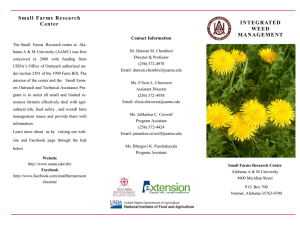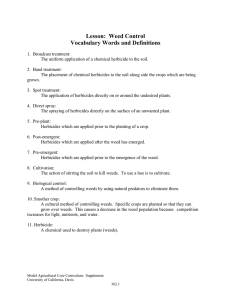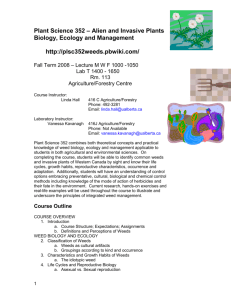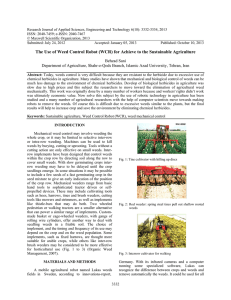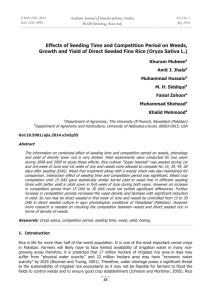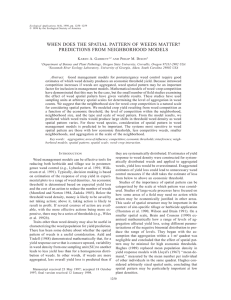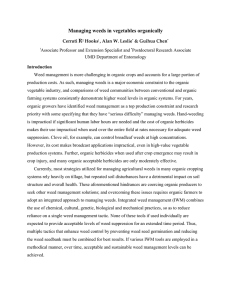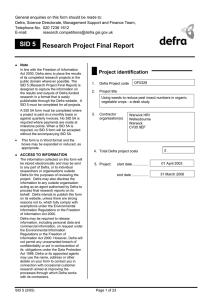Panel Discussion: Weed Management Don Stringfield
advertisement
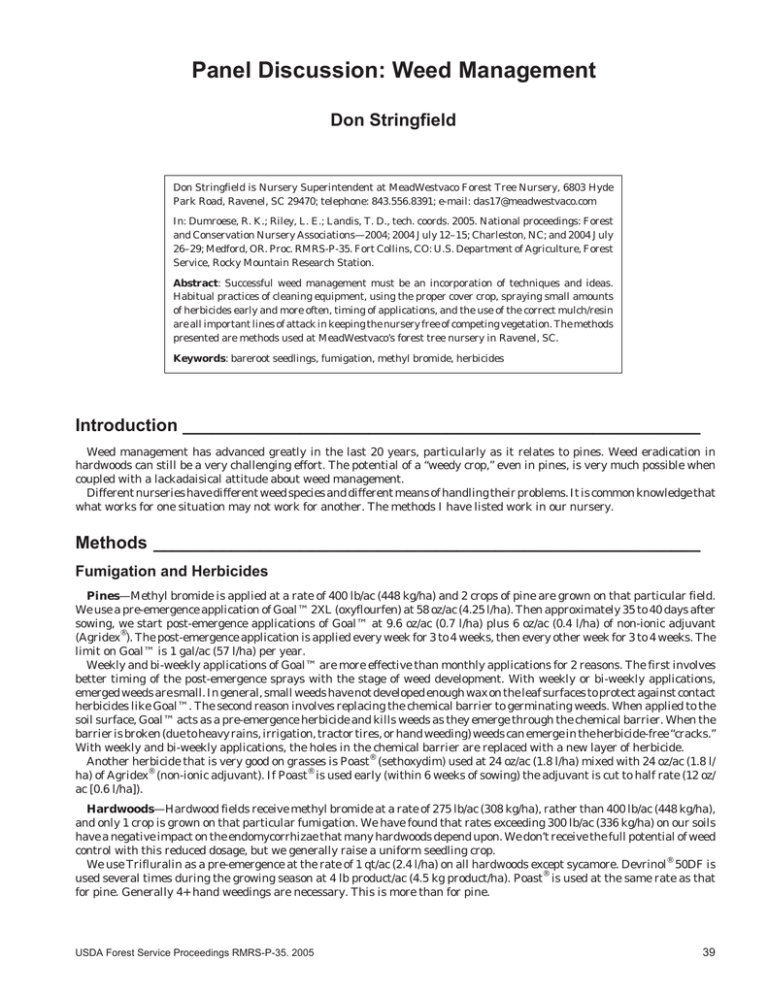
Panel Discussion: Weed Management Don Stringfield Don Stringfield is Nursery Superintendent at MeadWestvaco Forest Tree Nursery, 6803 Hyde Park Road, Ravenel, SC 29470; telephone: 843.556.8391; e-mail: das17@meadwestvaco.com In: Dumroese, R. K.; Riley, L. E.; Landis, T. D., tech. coords. 2005. National proceedings: Forest and Conservation Nursery Associations—2004; 2004 July 12–15; Charleston, NC; and 2004 July 26–29; Medford, OR. Proc. RMRS-P-35. Fort Collins, CO: U.S. Department of Agriculture, Forest Service, Rocky Mountain Research Station. Abstract: Successful weed management must be an incorporation of techniques and ideas. Habitual practices of cleaning equipment, using the proper cover crop, spraying small amounts of herbicides early and more often, timing of applications, and the use of the correct mulch/resin are all important lines of attack in keeping the nursery free of competing vegetation. The methods presented are methods used at MeadWestvaco’s forest tree nursery in Ravenel, SC. Keywords: bareroot seedlings, fumigation, methyl bromide, herbicides Introduction _____________________________________________________ Weed management has advanced greatly in the last 20 years, particularly as it relates to pines. Weed eradication in hardwoods can still be a very challenging effort. The potential of a “weedy crop,” even in pines, is very much possible when coupled with a lackadaisical attitude about weed management. Different nurseries have different weed species and different means of handling their problems. It is common knowledge that what works for one situation may not work for another. The methods I have listed work in our nursery. Methods ________________________________________________________ Fumigation and Herbicides Pines—Methyl bromide is applied at a rate of 400 lb/ac (448 kg/ha) and 2 crops of pine are grown on that particular field. We use a pre-emergence application of Goal™ 2XL (oxyflourfen) at 58 oz/ac (4.25 l/ha). Then approximately 35 to 40 days after sowing, we start post-emergence applications of Goal™ at 9.6 oz/ac (0.7 l/ha) plus 6 oz/ac (0.4 l/ha) of non-ionic adjuvant ® (Agridex ). The post-emergence application is applied every week for 3 to 4 weeks, then every other week for 3 to 4 weeks. The limit on Goal™ is 1 gal/ac (57 l/ha) per year. Weekly and bi-weekly applications of Goal™ are more effective than monthly applications for 2 reasons. The first involves better timing of the post-emergence sprays with the stage of weed development. With weekly or bi-weekly applications, emerged weeds are small. In general, small weeds have not developed enough wax on the leaf surfaces to protect against contact herbicides like Goal™. The second reason involves replacing the chemical barrier to germinating weeds. When applied to the soil surface, Goal™ acts as a pre-emergence herbicide and kills weeds as they emerge through the chemical barrier. When the barrier is broken (due to heavy rains, irrigation, tractor tires, or hand weeding) weeds can emerge in the herbicide-free “cracks.” With weekly and bi-weekly applications, the holes in the chemical barrier are replaced with a new layer of herbicide. ® Another herbicide that is very good on grasses is Poast (sethoxydim) used at 24 oz/ac (1.8 l/ha) mixed with 24 oz/ac (1.8 l/ ® ® ha) of Agridex (non-ionic adjuvant). If Poast is used early (within 6 weeks of sowing) the adjuvant is cut to half rate (12 oz/ ac [0.6 l/ha]). Hardwoods—Hardwood fields receive methyl bromide at a rate of 275 lb/ac (308 kg/ha), rather than 400 lb/ac (448 kg/ha), and only 1 crop is grown on that particular fumigation. We have found that rates exceeding 300 lb/ac (336 kg/ha) on our soils have a negative impact on the endomycorrhizae that many hardwoods depend upon. We don’t receive the full potential of weed control with this reduced dosage, but we generally raise a uniform seedling crop. ® We use Trifluralin as a pre-emergence at the rate of 1 qt/ac (2.4 l/ha) on all hardwoods except sycamore. Devrinol 50DF is ® used several times during the growing season at 4 lb product/ac (4.5 kg product/ha). Poast is used at the same rate as that for pine. Generally 4+ hand weedings are necessary. This is more than for pine. USDA Forest Service Proceedings RMRS-P-35. 2005 39 Stringfield Cover Crop We have tried several cover crops over the years. Since our sandy soils require more organic matter than any green manure crop can give us, we add our organic matter as fresh sawdust and plant a cover crop of Abruzzi rye (Secale cereale var. abrusses). Rye is planted in the fall (October); it has no competition from weeds at that time, thus no herbicides are needed. We let it grow until the next August or early September, then disk it in. We plant it again in October, or treat the field with methyl bromide if it is scheduled for a seedling crop. Abruzzi rye, when planted at 2.5 to 3.0 bushels/ac (6.3 to 7.5 bushels/ha) forms a dense 6 to 8 ft (2 to 2.4 m) tall crop that shades out competing vegetation all spring and summer. We add 20 tons/ac (50 tons/ha) of fresh sawdust on approximately 40 ac (16 ha) of land per year. As I said earlier, green manure crops, even at 2 per year, will not keep us in the range of organic matter we desire. Abruzzi rye fits our needs, our pocketbooks, and is low maintenance. Mulches Pines—We only use Agrilock®, a co-polymer resin. This has greatly reduced the introduction of weed seeds as compared to mulches used in the past. Hardwoods—All fall-sown hardwood seeds are covered with fresh sawdust (weedless), and then sprayed with ® Agrilock . Spring-sown hardwood seeds only receive the resin, no sawdust. Sawdust applied in the fall keeps the top of the seedling bed pliable. If sawdust is not applied, the bed will form a hard crust over winter, making seed emergence difficult, particularly on small-seeded species. 40 Panel Discussion: Weed Management We fall sow as many species of hardwoods as possible. Early spring growth means early canopy closure, which equals less weeds. Irrigation Lines Irrigation lines are sprayed the same time the seeding beds are sprayed, with whatever herbicide is being applied. Fallow Areas/Roadsides/Ditch Banks Fallow areas that stay fallow long enough to produce weeds will be treated with Roundup™ or its generic form at the labeled rate. Roadsides, field edges, and ditch banks are sprayed with Roundup™ several times during the spring and summer. Equipment Before a disk, turn-plow, chisel-plow, subsoiler, or dragharrow is moved from one field to another, it travels to the wash rack and is steam cleaned. This is particularly helpful in controlling nutsedge movement. Summary _____________________ Preventing the introduction, reproduction, and spreading of weeds, coupled with correct herbicides, proper rate, and time of application, all go hand-in-hand as a mechanism to control weeds year-round. USDA Forest Service Proceedings RMRS-P-35. 2005


